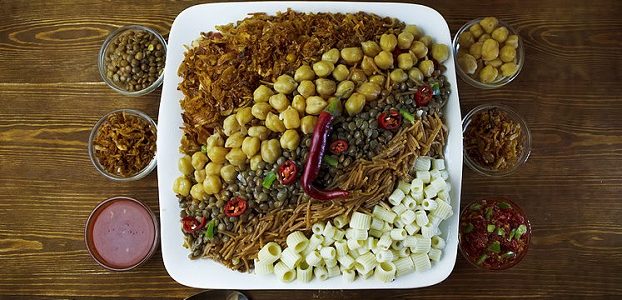Egyptian Food is part of our cultural identity
Egyptian food is known for most of our visitors but Most of us probably know this expression or at least heard it before, when you are in Rome, do Like the Romans do. ”. It means that whatever country you are visiting (living, working, etc.), it is polite to follow the customs of that society but it is not compulsory.
Kindly notice that Egypt is not only famous for its ancient monuments like Pyramids, Sphinx, Abu Simbel and Valley of the Kings but it is also famous for its food.
Egyptian food is a mixture of all the different civilizations that came to Egypt in the history of its existence. Nowhere in the world will you be able to taste so many cultures in one plate. Egyptian cuisine combines many of the best traditions of African, Middle Eastern and Mediterranean cooking, and is both delicious and healthy
Here are some of the most delicious Egyptian food dished you have to try while you are in Egypt.
Koshary
Koshary is a traditional Egyptian dish dating to the 19th century in which rice, pasta, homos and black lentils are mixed together in one plate with a topping of spicy tomato sauce and some crispy fried onions.
Having four sources of carbohydrates has made it the most popular lunch item in most common food outlets in Egypt for over 100 years. As they normally say you can not visit Egypt and not have Koshry.
It is sold from carts by street vendors, in restaurants or even made at home and each is considered a different taste experience. One big dish enough for one person almost 5 Egyptian pounds.
Fool and Falafel or an Egyptian Fava Beans Chili
Fool is the food for the poor and the elite there is an Arabic saying about this dish: “The rich man’s breakfast, the shopkeeper’s lunch, the poor man’s supper. Or with other words 90% of the Egyptian population have it as breakfast and may poor people will have it as dinner also.
Egyptian food Fool and Falafel is a great source of good carbs, protein and dietary fiber. It is served with oil, garlic and lemon juice and can be served with many embellishments such as butter, tomato sauce, tahina, fried or boiled eggs and pastrami.
The ta’meya, or Egyptian falafel is made out of crushed Fava beans that is later mixed and made into a paste then fried,
Kofta
This one is for the beef or lamb lovers One of the easiest preparations for beef and lamb, it’s popular to make at home or to buy from a recipe for your next family dinner.
Normally we mix Onion, garlic with the spices, parsley and the meat very well, leave them like ten minutes then shape them like Kofta and spray them with tomatoes and onion juice.
In a large pan we put some Olive oil then we put the Kofta in the pan then in oven for about twenty minuets. Kofta will be ready then to serve in a sandwich or with Tehina or yogurt dip and mini pita breads on the side.
Molokheya
Many Egyptian consider Molokheya to be the national dish along with fool and Koshary. Molokheya is a very good source of vitamin E Vitamin C Iron and is also antioxidants.
It is a green soup made of jute plant leaves very finely chopped, with ingredients such as garlic and coriander added to give it a characteristic aromatic taste.
It can be eaten either with Egyptian bread or with rice and it is typically a lunch dish. It is said that the original name for Molokheya is Molokeyya meaning (“of the kings”), and that the public turned the word from Molokeyya to Molokheya.
Shawerma
Shawerma is not originally a native Egyptian dish and it is made out of chicken breasts or just white chicken meat, into long, slim strips, then into lengths that are about an inch long.
Put them into a bowl or other container, and allow them to marinate in the lemon juice, olive oil, crushed and diced garlic, yogurt, tomato paste, salt, pepper and spices.
Shawerma is eaten as a fast food, made up into a sandwich wrap with pita bread or rolled up in an Armenian Lavash flatbread together with vegetables and dressing. A variety of vegetables come with the Shawerma which include: cucumber, onion, tomato, lettuce, eggplant, parsley, pickled turnips and pickled gherkins
